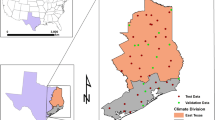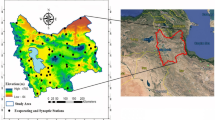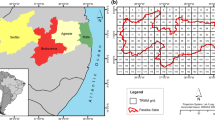Abstract
Estimation and identification of long-term meteorological drought pattern play an important role in regional water management and dry land agricultural practices in arid and semiarid climates. In this work, Standardized Precipitation Index (SPI) has been selected as the main criterion for evaluating the severity of meteorological drought events. The purpose of this paper was to produce meteorological drought occurrence probability maps for different SPI classes by spatiotemporal analysis. Several statistical methods known as non-geostatistical approaches (such as Thiessen polygons, inverse distance-weighted, and spline-based) and geostatistical approaches (such as different types of kriging and Bayesian maximum entropy (BME)) are available, which can be used for the purpose of this study. In this study, ordinary kriging (OK) as a classical geostatistical method and BME as a modern geostatistical method have been used. The case study of this research has been the Namak Lake Watershed located in the central part of Iran with an area of approximately 90,000 km2. This basin includes regions with significantly different climatic conditions ranging from very dry to very wet. The results of the case study include spatial distribution of SPI for dry SPI classes (moderately, severely, and extremely dry classes) and wet SPI classes (moderately, severely, and extremely wet classes) which can be used to locate vulnerable areas against drought. The selected geostatistical methods have been compared based on leave-one-out cross-validation procedure and spatiotemporal distribution of SPI values. The results of cross-validation have shown the superiority of BME over OK. BME maps of probability of occurrence have also been more realistic than OK maps.












Similar content being viewed by others
References
Abedini MJ, Nasseri M (2008) Inverse distance weighted revisited. 4th APHW, Beijing, China, 3–5 November 2008
Abedini MJ, Nasseri M, Ansari A (2008) Cluster-based ordinary Kriging of piezometric head. J Hydrol 351:360–367
Abedini MJ, Nasseri M, Burn D (2012) The use of a genetic algorithm-based search strategy in geostatistics: application to a set of anisotropic piezometric head data. Comput Geosci 41:136–146
Abramowitz M, Stegun A (eds) (1965) Handbook of mathematical formulas, graphs, and mathematical tables. Dover Publications Inc, New York
Akhtari R, Morid S, Mahdian MH, Smakhtin V (2009) Assessment of areal interpolation methods for spatial analysis of SPI and EDI drought indices. Int J Climatol 29:135–145. doi:10.1002/joc.1691
Basistha A, Arya DS, Goel NK (2008) Spatial distribution of rainfall in Indian Himalayas—a case study of Uttarakhand region. Water Resour Manage 22:1325–1346
Bayat B, Zahraie B, Taghavi F, Nasseri M (2012) Evaluation of spatial and spatiotemporal estimation methods in simulation of precipitation variability patterns. Theoret Appl Climatol. doi:10.1007/s00704-012-0795-7
Burrough PA, McDonnell RA (1998) Principles of geographical information systems. Oxford University Press, Oxford
Chiles JP, Delfiner P (1999) Geostatistics. Modeling Spatial Uncertainty, Wiely
Christakos G (1998) Spatiotemporal information systems in soil and environmental sciences. Geoderma 85(2–3):141–179
Christakos G (2000) Modern spatiotemporal geostatistics. Oxford University Press, New York
Christakos G, Bogaert P, Serre ML (2002) Temporal GIS. Springer, New York
Cressie N, Huang HC (1999) Classes of nonseparable, spatio-temporal stationary covariance functions. J Am Stat As 94:1330–1340
De Cesare L, Myers D, Posa D (1997) Spatial-temporal modeling of SO_2 in milan district. In: Baafi EY, Schofield NA (eds) Geostatistics wollongong’96, vol 2. Kluwer Academic, Dordrecht, pp 1031–1042
De Cesare L, Myers D, Posa D (2001a) Product-sum covariance for space-time modeling. Environmetrics 12:11–23
De Cesare L, Myers D, Posa D (2001b) Estimating and modeling space-time correlation structures. Stat Probab Lett 51:9–14
De Iaco S, Myers D, Posa D (2001) Space-time analysis using a general product-sum model. Stat Probab Lett 52:21–28
De Iaco S, Myers D, Posa D (2002) Space–time variograms and a functional form for total air pollution measurements. Comput Stat Data Anal 41:311–328
Deo RC (2011) On meteorological droughts in tropical Pacific Islands: time-series analysis of observed rainfall using Fiji as a case study. Meteorol Appl 18:171–180
Diggle PJ, Tawn JA, Moyeed RA (1998) Model-based geostatistics. J Roy Stat Soc Ser C (Appl Stat) 47:299–350. doi:10.1111/1467-9876.00113
Douaik A, Van Meirvenne M, To’th T, Serre M (2004) Space–time mapping of soil salinity using probabilistic Bayesian maximum entropy. Stoch Env Res Risk As 18:219–227
Douaik A, Van Meirvenne M, Tóth T (2005) Soil salinity mapping using spatio-temporal kriging and Bayesian maximum entropy with interval soft data. Geoderma 128:234–248
Edwards DC, McKee TB (1997) Characteristics of 20th century drought in the United States at multiple time scales. Climatology report number 97–2. Colorado, State University: Fort Collins, CO
Genton MG (2007) Separable approximations of space-time covariance matrices. Environmetrics 18:681–695
Gibbs WJ, Maher JV (1967) Rainfall deciles as drought indicators, bureau of meteorology bulletin no. 48. Commonwealth of Australia: Melbourne, p 29
Guttman NB (1998) Comparing the palmer drought index and the standardized precipitation index. J Am Water Resour As 34:113–121
Hayes MJ, Svodoba MD, Wilhite DA, Vanyarkho OV (1999) Monitoring the 1996 drought using the standardized precipitation index. Bull Am Meteor Soc 80:429–438
Isaaks EH, Srivastava RM (1989) An introduction to applied geostatistics. Oxford University Press, New York
JAMAB (1999) Iran water comprehensive project: daryacheh namak drainage area (base study). Consulting Engineers in Association with Ministry of Energy, Iran (In Persian)
Kitanidis PK (1997) Introduction to geostatistics: applications to hydrogeology. Cambridge University Press, UK
Kumar MN, Murthy CS, Sesha Sai MVR, Roy PS (2011) Spatiotemporal analysis of meteorological drought variability in the Indian region using standardized precipitation index. Meteorol Appl. doi:10.1002/met.277
Lebel T, Bastin G, Obled C, Creutin JD (1987) On the accuracy of areal rainfall estimation: a case study. Water Resour Res 23(11):2123–2138
Li J, Heap AD (2008) A review of spatial interpolation methods for environmental scientists. Canberra, Geoscience Australia
Livada I, Assimakopoulos VD (2007) Spatial and temporal analysis of drought in Greece using the standardized precipitation index (SPI). Theoret Appl Climatol 89(3–4):143–153
Logan KE, Brunsell NA, Jones AR, Feddeme JJ (2010) Assessing spatiotemporal variability of drought in the U.S. central plains. J Arid Environ 74:247–255
Loukas A, Vasiliades L (2004) Probabilistic analysis of drought spatiotemporal characteristics in Thessaly region, Greece. Nat Hazards Earth Syst Sci 4:719–731
McKee TB, Doesken NJ, Kleist J (1993) The relationship of drought frequency and duration to time scales. In: Proceeding of the 8 th conference on applied climatology, 17–22 January 1993. Anaheim, California, pp 179–184
McKee TB, Doesken NJ, Kleist J (1995) Drought monitoring with Multiple Time scales. Proceeding of the ninth conference on applied climatology. American Meteorological Society, Dallas, TX, pp 233–236
Nasseri M, Zahraie B (2011) Application of simple clustering on space-time mapping of mean monthly rainfall pattern. Int J Climatol 31(5):732–741. doi:10.1002/joc.2109
Pai DS, Sridhar L, Guhathakurta P, Hatwar HR (2011) District-wide drought climatology of the southwest monsoon season over India based on standardized precipitation index (SPI). Nat Hazards 59:1797–1813
Painter S (1998) Numerical method for conditional simulation of Levy random fields. Math Geol 30(2):163–179
Palmer WC (1965) Meteorological drought. Research paper no. 45. U.S. Department of Commerce Weather Bureau, Washington, DC
Patel NR, Chopra P, Dadhwal VK (2007) Analyzing spatial patterns of meteorological drought using standardized precipitation index. Meteor Appl 14:329–336
Philips DL, Dolph J, Marks D (1992) A comparison of geostatistical procedures for spatial analysis of precipitations in mountainous terrain. Agr For Meteor 58:119–141
Serre ML, Christakos G (1999) Modern geostatistics: computational BME analysis in the light of uncertain physical knowledge - the Equus Beds study. Stoch Env Res Risk Assess 13:1–26
Shepard D (1968) A two-dimensional interpolation function for irregularly-spaced data. Proceedings of the 1968 ACM national conference, pp 517–524
Sönmez FK, Kömüscü AU, Erkan A, Turgu E (2005) An analysis of spatial and temporal dimension of drought vulnerability in Turkey using the standardized precipitation index. Nat Hazards 35:243–264
Tabios GQ, Salas JD (1985) A comparative analysis of techniques for spatial interpolation of precipitation. Water Resour Bull 21(3):365–380
Tartakovsky DM, Wohlberg B, Guadagnini A (2007) Nearest-neighbor classification for facies delineation. Water Resour Res 43:W07201. doi:10.1029/2007WR005968
Thiessen AH (1911) Precipitation averages for large areas. Mon Weather Rev 39(7):1082–1084
Thom HCS (1966) Some methods of climatological analysis. WMO Tech Note 81:16–22
Vicente-Serrano SM (2007) Evaluating the impact of drought using remote sensing in a mediterranean, semi-arid region. Nat Hazards 20:37–60
Wu H, Hayes MJ, Welss A, Hu Q (2001) An evaluation the standardized precipitation index, the china-z index and the statistical z-score. Int J Climatol 21:745–758. doi:10.1002/joc.658
Yarus JM, Chambers RL (2005) Stochastic modeling and geostatistics principles, methods, and case studies, vol II. The American Association of Petroleum Geologists Press, Tulsa, Oklahoma
Yu HL, Chu HJ (2010) Understanding space–time patterns of groundwater system by empirical orthogonal functions: a case study in the Choshui River alluvial fan, Taiwan. J Hydrol 381:239–247
Author information
Authors and Affiliations
Corresponding author
Appendices
Appendix 1
Considering gamma distribution in this paper, the PDF of this distribution is defined as:
where x, α > 0, and β > 0 are the precipitation values, shape parameter, and scale parameter, respectively. Γ(α) is the gamma function which is defined as:
Optimum α and β are calculated as follows:
where \(A = \ln (\bar{x}) - \frac{{\sum {\ln (x)} }}{n}\) and n is the number of observations. To calculate SPI values, cumulative distribution function (CDF) which is the integration of PDF should be obtained as follows:
Since the gamma distribution is undefined at 0 and precipitation series may include zero entries, the CDF must be corrected as follows:
where q is the probability of zero precipitation.
The transformation is defined as:
where
and the optimum parameters of Eq. (17) are c 0 = 2.515517, c 1 = 0.802853, c 2 = 0.010328, d 0 = 1.432788, d 1 = 0.189269, and d 2 = 0.001308. Actually, SPI represents deviation from average.
Appendix 2
-
1.
Normalized mean square error (NMSE):
$${\text{NMSE}} = \frac{1}{{S^{2} N}}\sum\limits_{i = 1}^{N} {\left\{ {X(\vec{s}_{i} ) - \hat{X}(\vec{s}_{i} )} \right\}^{2} } ,$$(19)S2: Variance of the observed values. N: number of observed values. \(X(\vec{s}_{i} )\): observed values in location \(\vec{s}_{i}\). \(\hat{X}(\vec{s}_{i} )\): estimated values in location \(\vec{s}_{i}\).
This index is estimated based on the variance of observed values.
-
2.
Mean absolute error (MAE) or bias
$${\text{MAE}} = \frac{1}{N}\sum\limits_{i = 1}^{N} {{\text{abs}}\left\{ {X(\vec{s}_{i} ) - \hat{X}(\vec{s}_{i} )} \right\}} .$$(20)abs: absolute value (B-2).
-
3.
Mean square error (MSE):
$${\text{MSE}} = \frac{1}{N}\sum\limits_{i = 1}^{N} {\left\{ {X(\vec{s}_{i} ) - \hat{X}(\vec{s}_{i} )} \right\}}^{2} .$$(21)
Rights and permissions
About this article
Cite this article
Bayat, B., Nasseri, M. & Zahraie, B. Identification of long-term annual pattern of meteorological drought based on spatiotemporal methods: evaluation of different geostatistical approaches. Nat Hazards 76, 515–541 (2015). https://doi.org/10.1007/s11069-014-1499-3
Received:
Accepted:
Published:
Issue Date:
DOI: https://doi.org/10.1007/s11069-014-1499-3




